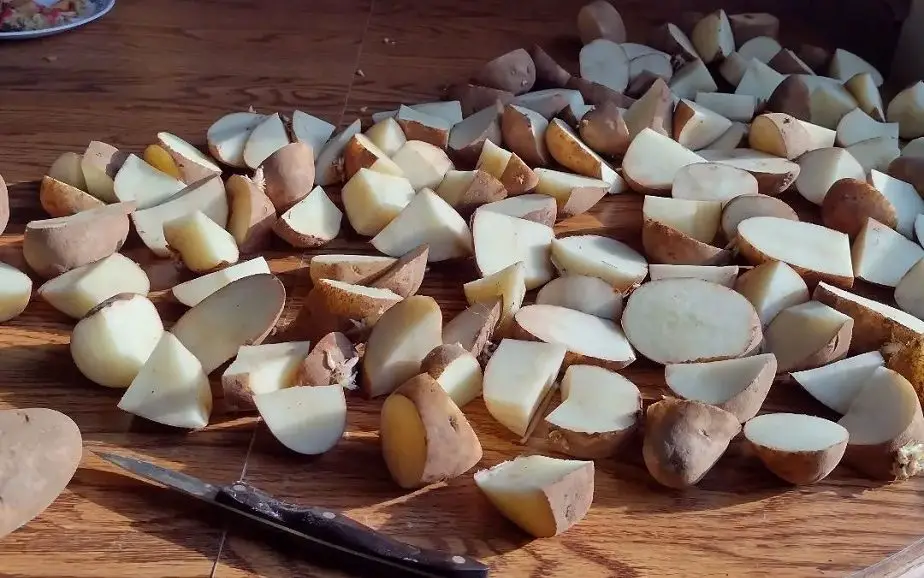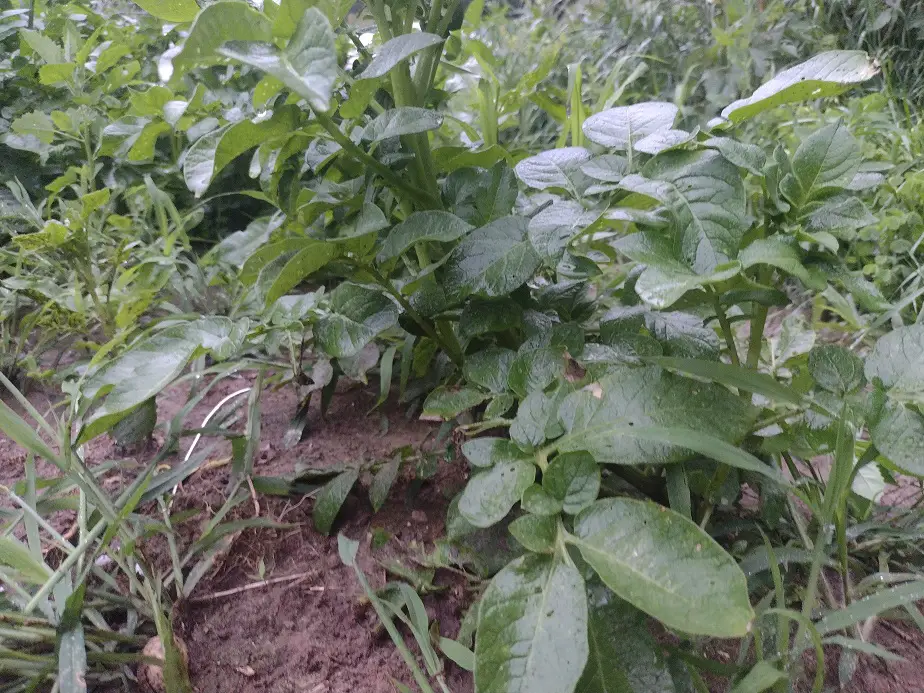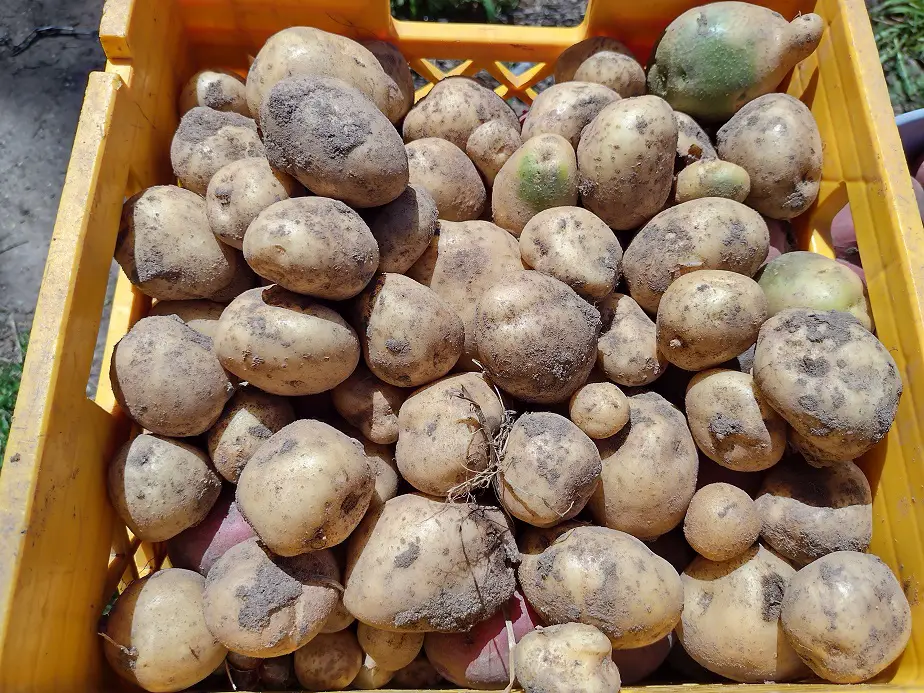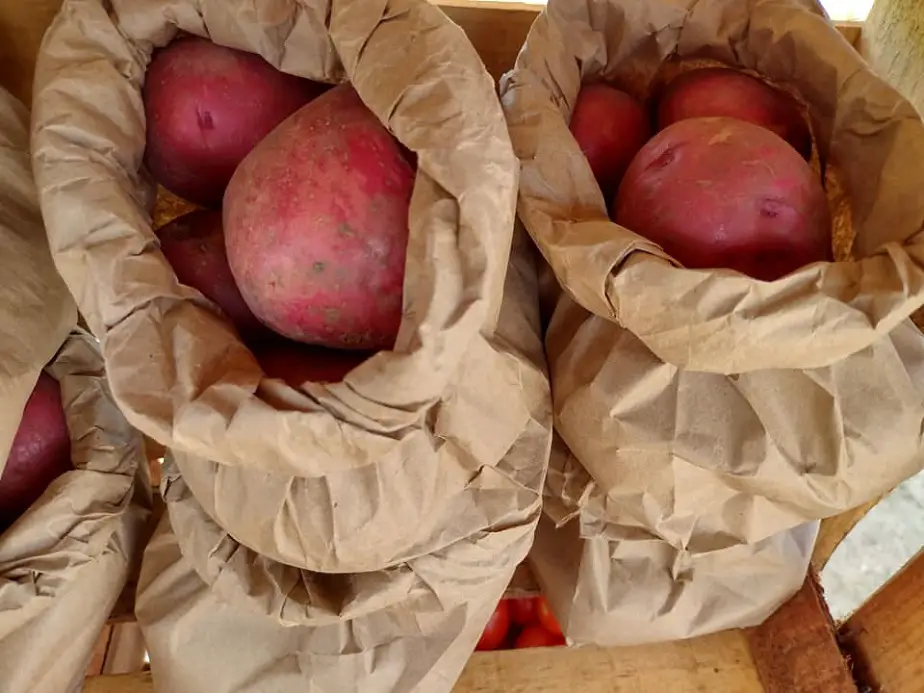We bought 50 pounds of seed potato this year. They’re more expensive than store-bought potatoes, what’s the big difference anyway?
Both seed potatoes and grocery store potatoes can be planted and can grow a good harvest. Growers take extra care to ensure seed potatoes are disease-free, but there is seldom any noticeable difference. Seed potato’s eyes are usually already sprouting, but store-bought potatoes need to be pre-sprouted.
I ran an experiment this year by planting both certified seed potatoes and grocery store potatoes. Here’s what I found out.
Seed Potatoes vs Grocery Store Potatoes, how they’re treated differently.
The two types of potatoes are grown, stored, and handled differently. Each slightly benefitting its own intended purpose. The first thing you’ll notice about seed potatoes is that they’re usually dirty. Seed potatoes are unwashed, in part because there’s no need to wash them, but also to help them grow.
Something I’ve learned from selling produce at the farmer’s market is that washing vegetables is hard on them. Even if I’m being gentle, it still damaged the skin and lowers the storage life considerably. That’s why back in the day, produce wasn’t pre-washed. Things lasted better that way.
Washing potatoes somewhat reduces the sproutability because some of the eyes get damaged. In theory, it makes a difference. Personally, I see a lot of sprouted eyes on old potatoes. Another way they are handled differently is in storage.
Eating potatoes are stored cool and humid, so they don’t dry out. This increases the chances of a little rot but keeps them from drying out and getting soft. Seed Potatoes are stored cool and dry, so they don’t rot at all. It also helps thicken the skin, which improves planting success.
When you buy seed potatoes from a garden center, they’re usually wrinkled, a little soft, and already sprouted. That’s normal. For mechanical planting, they don’t want them too soft or sprouted much, but it suits the home gardener who can be a bit gentle with things.

Do Seed Potatoes Have Less Disease?
If you buy seed potatoes you’ll see they are labeled “certified seed potatoes”. That means they have been grown with strict care to be disease-free and healthy. There is a chance, though not a big one, that grocery store potatoes could carry a fungus or virus that will hurt your crop.
What’s the danger of planting something other than “certified seed”? Not much really. Technically yes, seed potatoes are grown with greater care, But framers tend to put great care into every crop, seed or not. I haven’t seen, nor have I heard, of any issue after planting uncertified potatoes i.e. grocery store ones.
Right now, I have 2 rows of Idaho Russets that were not “seed potatoes”. They are growing as Russets should by the looks of it. I planted the same thing several years ago, next to a crop of Red Pontiac. They all grew well, remained healthy, and harvested a decent yield.
Seed potatoes have a much lower chance of having disease than grocery store potatoes, but after growing both several times, I’ve not seen a legitimate difference in plant health.
Sprouting Grocery Store Potatoes vs Seed Potatoes

Most of the time, seed potatoes are already sprouted by the time you get them. They’re ready to plant. Sometimes, the spouts are very long, too long, and crack off during planting. That’s not good.
I had some purple seed potatoes like that this spring. We handled them and planted them extra carefully. Ideally, sprouts should be little more than a lumpy growth knob coming out of the eye of a potato. If the sprouts get long and crack off, they may not re-grow.
Grocery store potatoes benefit from sprouting a bit before planting. I bet you’ve seen a potato start to sprout before. All you have to do is set them out at room temperature for two weeks or so. I like to simply leave them in the panty until they start popping. Check them every few days.
In warm temperatures, potato sprouts can grow quickly all of the sudden. You don’t want them getting too long. I prefer under an inch of sprouts. If you see the slightest growth from an eye, they can be considered good for planting. If you are planting potatoes in cold weather, letting the sprouts get more pronounced can benefit them.

Do Seed Potatoes Grow Better than Grocery Store Potatoes?
Seed Potatoes are technically better and usually start growing faster than planted grocery store potatoes, but there’s little discernable difference in the quality and size of the harvest. I can see little difference in their growth or health during the growing season.
If you’re thinking about planting regular potatoes, don’t be bashful. It will do alright. It’s actually fairly common to plant regular eating spuds. You should just let them sprout a bit first. That’s called chitting. Really, the only difference I’ve seen is that you should pre-sprout them first.
I have noticed that it can take a while to get them going at first, but once sprouted and planted, they grow like an average potato. I actually just reminded myself that I need to add fertilizer to the grocery store Russets I planted.
Some potato processing facilities apply a chemical called chlorpropham to potatoes, which slows the sprouting process. They’ll still sprout and grow well. Mine always seem to sprout within a month. Be sure and get them at least a month before you want to plant them.
Which One is the Best Option?
In my opinion, it really comes down to price. Often, seed potatoes are more expensive. In my area, the garden centers and Tractor Supply Co sell a 4-pound bag of Russet seed potatoes for 6 dollars. I can go down the road and get a 5-pound bag of Russets for $2.87 at the grocery store.
To plant enough for my family for a year, potatoes a few times a week (about 350 pounds), would take at least 70 plants. Let’s say we get a poor harvest, so it would take twice that. 140 plants. Depending on how I cut them up, that’s 15-20 pounds to buy for planting. That’s a $15 difference, enough for fertilizer.
I don’t mean to cry about a few dollars. Sometimes, varieties are only available from specialty garden retailers and that’s fine. I lived for a long time where 15 dollars was the difference between eating and going hungry, so I tend to look to save a few bucks where I can. Some types are no cheaper to buy that way, but it works for the basic potatoes.
Where to Buy Good Seed Potatoes
If you can find a bulk seller of seed potatoes, you’re in luck! Our local grain elevator sells all the common types of bulk seeds, including seed potatoes. This year, they had 6 varieties of potatoes for fifty cents a pound. If you have a farmer’s co-op store, a farm supply store (not one of those chain stores), or a grain elevator in the area, give them a call on prices first.
If money is at all an issue, I would avoid buying potatoes online and having them shipped. That gets expensive fast. If you are having a hard time finding decently priced seed potatoes, ask around in local gardening groups on Facebook, or ask a local farmer.
If you do buy the pricey seed potatoes, remember you can save some of them as seed potatoes for the next year. All you have to do is keep them dry, cool, and completely out of light. This year I bought expensive Adirondack Blue seed potatoes. We’re saving 10 pounds for next spring’s planting.

Saving Your Own Seed Potatoes
To Save your potatoes for planting, leave them in the ground until the vines are completely brown and dry. Dig them carefully and wipe off dirt clumps. Don’t wash them. Store them in a ventilated container in the coolest, darkest, dry area you have. Check them periodically and remove any rotten ones.
It’s very imp[ortant that potatoes saved for planting are kept cool. Warm potatoes are much more likely to spoil quickly. Keeping them dry also helps prevent rot. Seed potatoes don’t like a wet or humid environment. Humidity encourages sprouting too.
Darkness helps slow the sprouting process. you don’t want them sprouting too early. The biggest challenge with saving seed potato is keeping them from over sprouting. Over the winter months, potatoes can grow sprouts well over a foot long if they are too eager to grow.
If the eyes grow too long of sprouts, they will break when handling and not grow when planted. It also uses up energy from the potato.
Preparing Potatoes for Planting
If not already sprouted, leave the seed potatoes in a warm place for 2 weeks to encourage sprouting. When the sprouts are budding, 1/4-inch to 1-inch, They are ready. It’s usually recommended to cut up the potatoes into smaller pieces. Every pound of seed potato should contain about 10 individual pieces.
Seed potatoes the size of a chicken egg can be cut in half or kept whole. Larger ones are cut into multiple pieces. Make sure that there is at least one budding sprout per piece. Leave the pieces out of the sun and uncovered, cut side up for a day. The cuts will have scabbed over and they are prepared for planting.
All that’s left now is to decide how you will plant them. Will you plant shallow and hill as they grow? Will you do the trench method, or maybe try growing in grow bags? There are pros and cons to each. Let me recommend a few related articles to get you going.
Related Articles:

